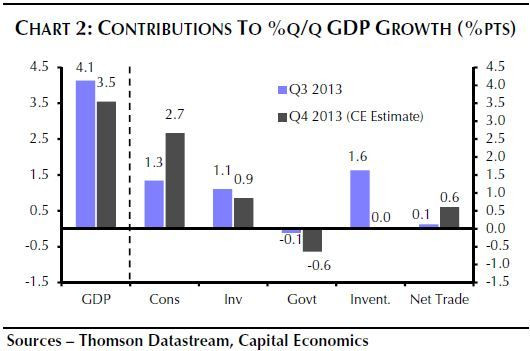Households, Trade Boost U.S. Fourth-Quarter Growth

By Lucia Mutikani
WASHINGTON (Reuters) - Robust household spending and rising exports kept the U.S. economy on solid ground in the fourth quarter, but stagnant wages could chip away some of the momentum in early 2014.
Gross domestic product grew at a 3.2 percent annual rate, the Commerce Department said on Thursday, in line with expectations.
While that was a slowdown from the third quarter's brisk 4.1 percent pace, it was a far stronger performance than earlier anticipated and was welcome news in light of a 0.3 percentage point drag from October's partial government shutdown and a much smaller contribution to growth from a restocking by businesses.
Earlier in the quarter, many economists were anticipating a growth pace below 2 percent, given that an inventory surge accounted for much of the increase in the July-September period.
Growth over the second half of the year come in at a 3.7 percent pace, up sharply from 1.8 percent in the first six months of the year. It was the biggest half-year increase since the second half of 2003.
Consumer spending was the main driver of fourth-quarter growth, but there was also help from other segments of the economy such as trade and business investment.
The advance fourth-quarter GDP was released a day after the Federal Reserve said "growth in economic activity picked up in recent quarters."
The Fed on Wednesday announced another reduction to its monthly bond purchases and appeared to shrug off a surprise sharp slowdown in job growth in December.
Consumer spending rose at a 3.3 percent rate, the strongest since the fourth quarter of 2010. Consumer spending, which accounts for more than two-thirds of U.S. economic activity, advanced at a 2 percent pace in the third quarter.
Businesses accumulated $127.2 billion worth of inventories, the most since the first quarter of 1998, adding 0.42 percentage point to GDP growth. Inventories had increased $115.7 billion in the third quarter, contributing 1.67 percentage points to output.
Excluding inventories, the economy grew at a 2.8 percent rate, up from the third quarter's 2.5 percent rate.
SOLID FINAL DEMAND
The sturdy increase in final demand should put the economy on a stronger growth path this year. However, a lack of wage growth could take some edge off consumer spending early in the year.
A feared inventory correction, which didn't materialize in the fourth quarter, is now likely to show up in the first three months of the year and weigh on growth, economists say.
In addition, business investment is expected to moderate, given a surprise tumble in orders for capital goods excluding defense and aircraft in December.
Even so, a lessening of the fiscal austerity that gripped Washington last year should keep the economy on a firmer growth path. Growth for the whole of this year is forecast at 2.9 percent, up from last year's 1.9 percent.
Wage growth has been stagnant as the economy deals with slack in the labor market. Consumption in the fourth quarter came at the expense of saving.
The saving rate slowed to 4.3 percent in the fourth quarter from 4.9 percent in the prior period. Real disposable personal income increased 0.8 percent in the fourth quarter, following an increase of 3.0 percent in the third quarter.
Sluggish wages kept inflation pressures benign in the fourth quarter. A price index in the GDP report rose at a 0.7 percent rate, decelerating from the third quarter's 1.9 percent pace.
A core measure that strips out food and energy costs increased at a 1.1 percent rate after advancing at a 1.4 percent pace in the July-September period.
The economy in the last quarter also got a boost from exports, thanks to firmer global growth. That, together with declining petroleum imports, narrowed the trade deficit.
Business spending on equipment accelerated at a 6.9 percent rate in the fourth quarter after rising at only a 0.2 percent pace in the prior three months.
There was a decline in business spending on nonresidential structures in the fourth quarter. A run-up in mortgage rates, which held back home sales and renovations, saw residential investment falling for the first time since the third quarter of 2010.
Government spending contracted at a 4.9 percent pace, reflecting a 16-day partial shutdown of the federal government in October. The Commerce Department said the shutdown had reduced GDP growth by 0.3 percentage point, through reduction in hours worked by federal employees.
(Reporting by Lucia Mutikani; Editing by Andrea Ricci)
© Copyright IBTimes 2024. All rights reserved.
Join the Discussion




















